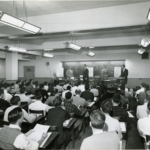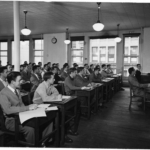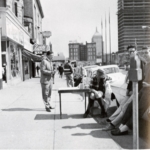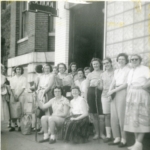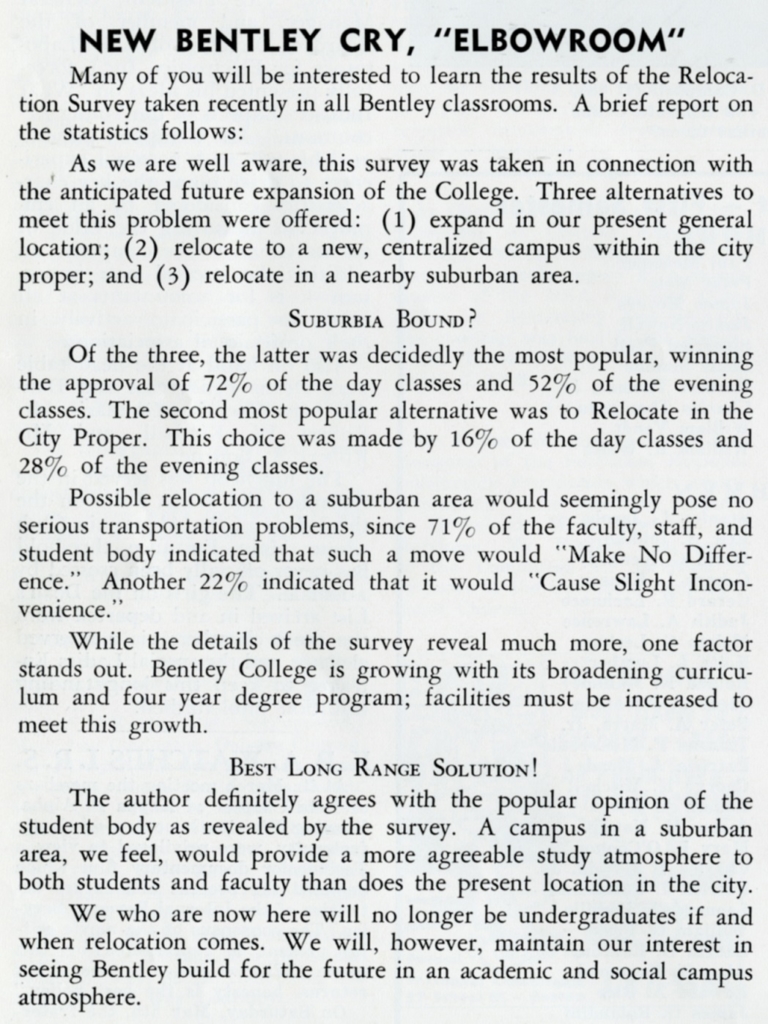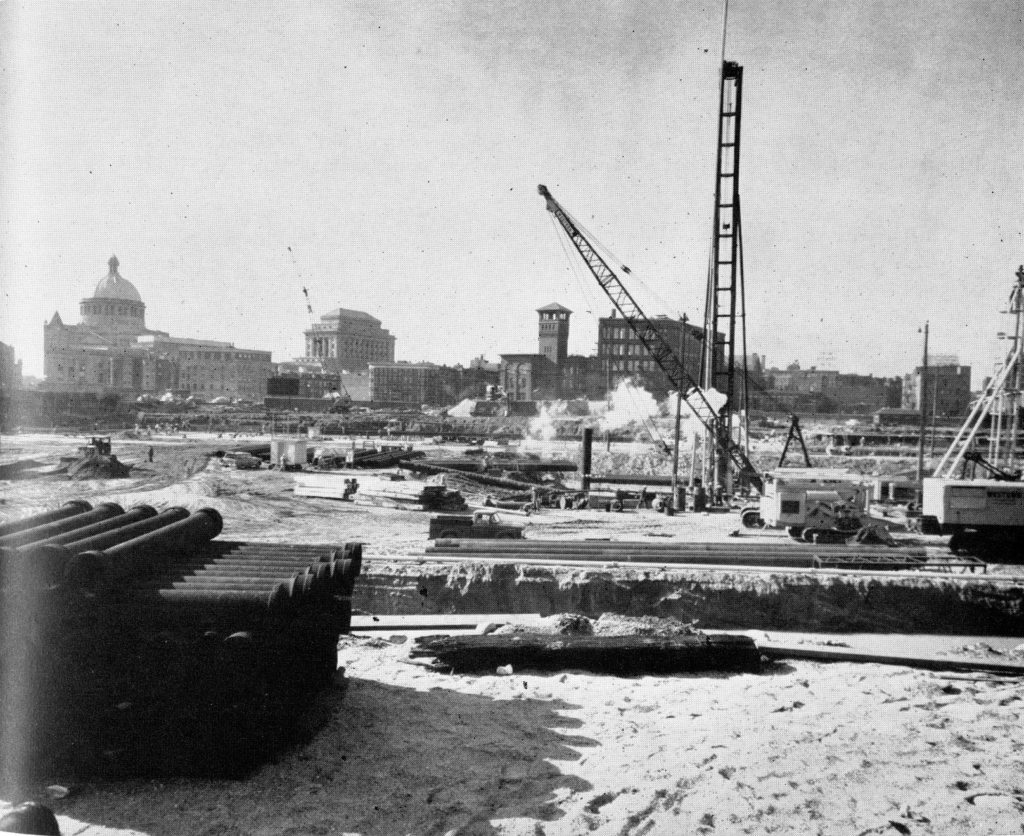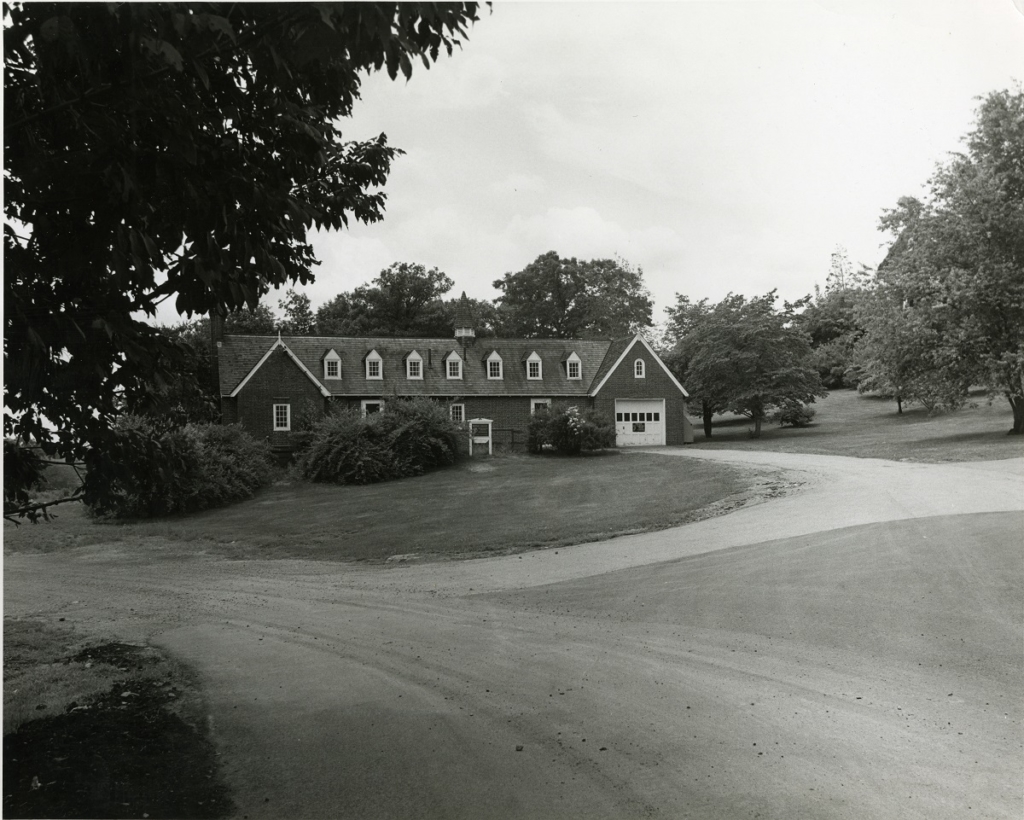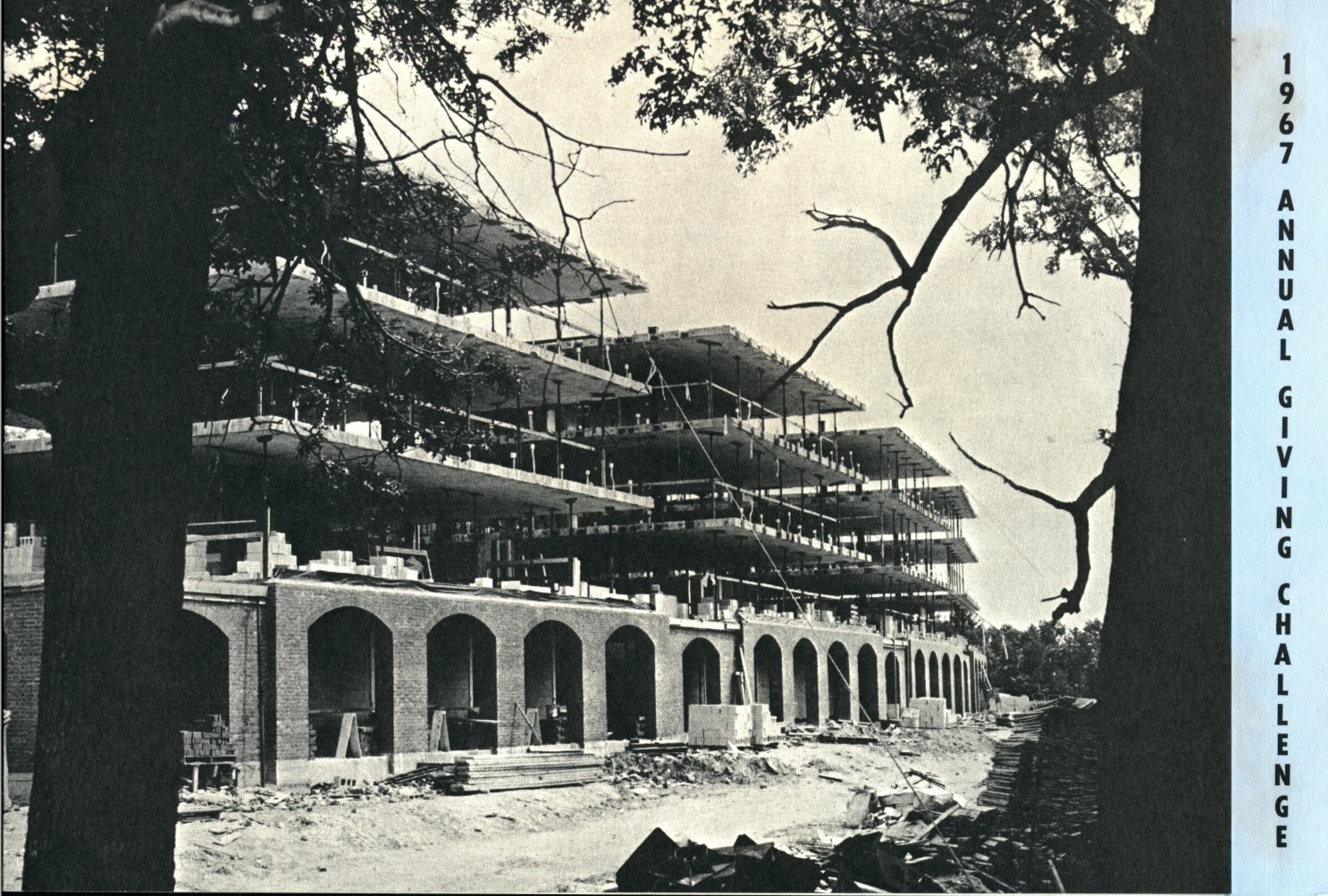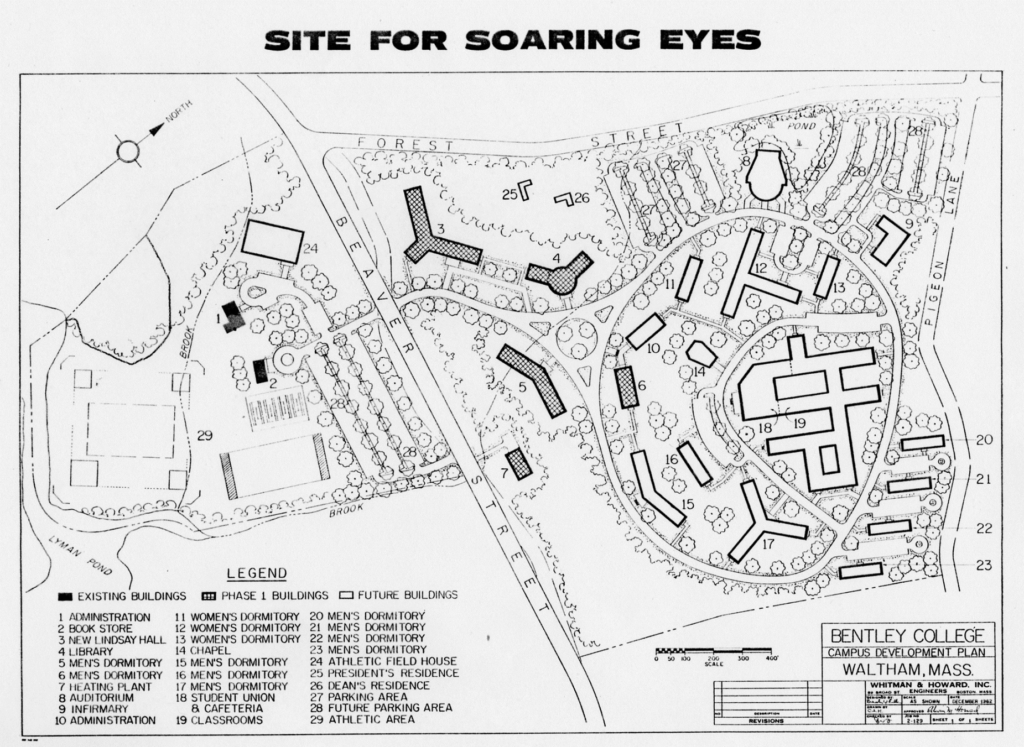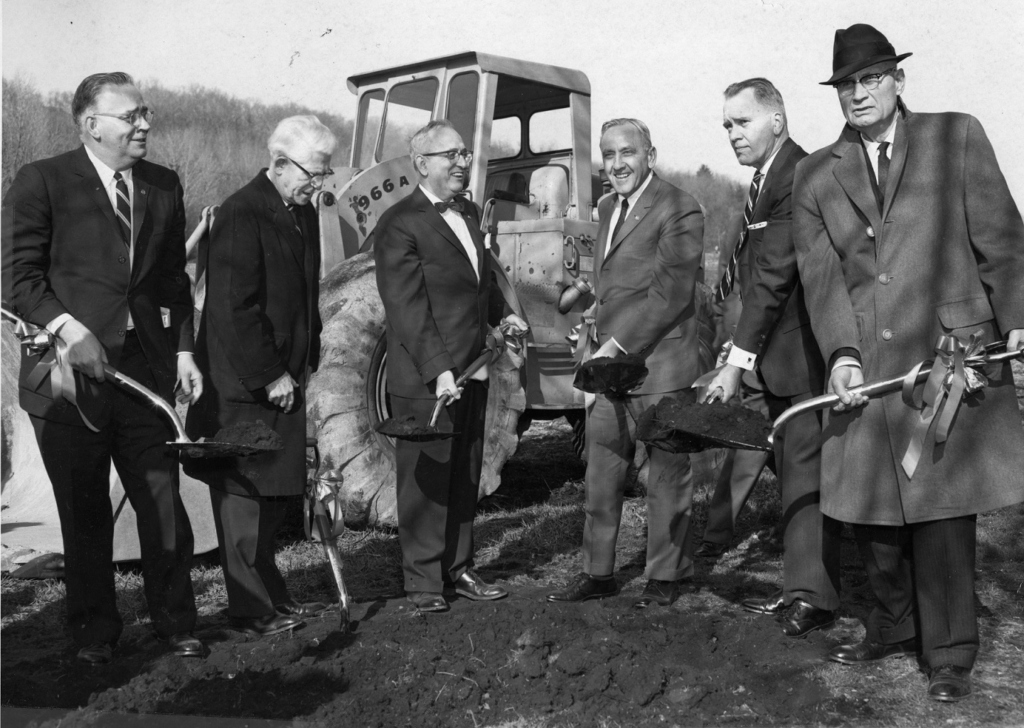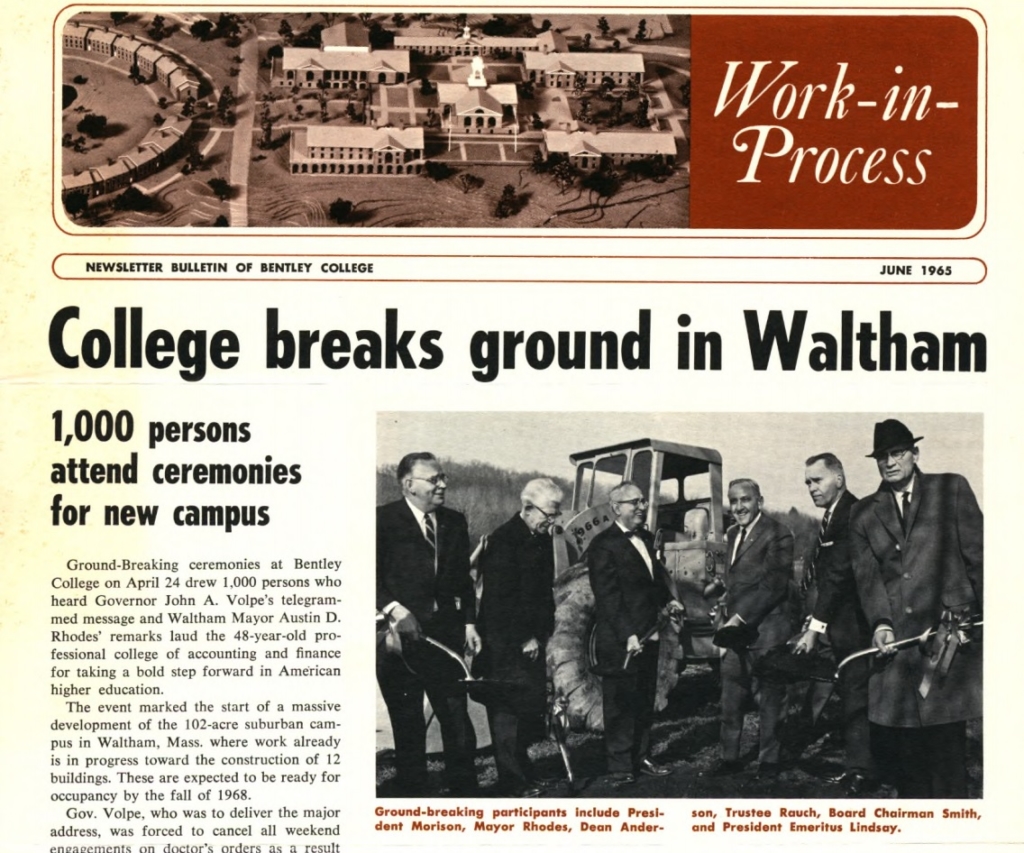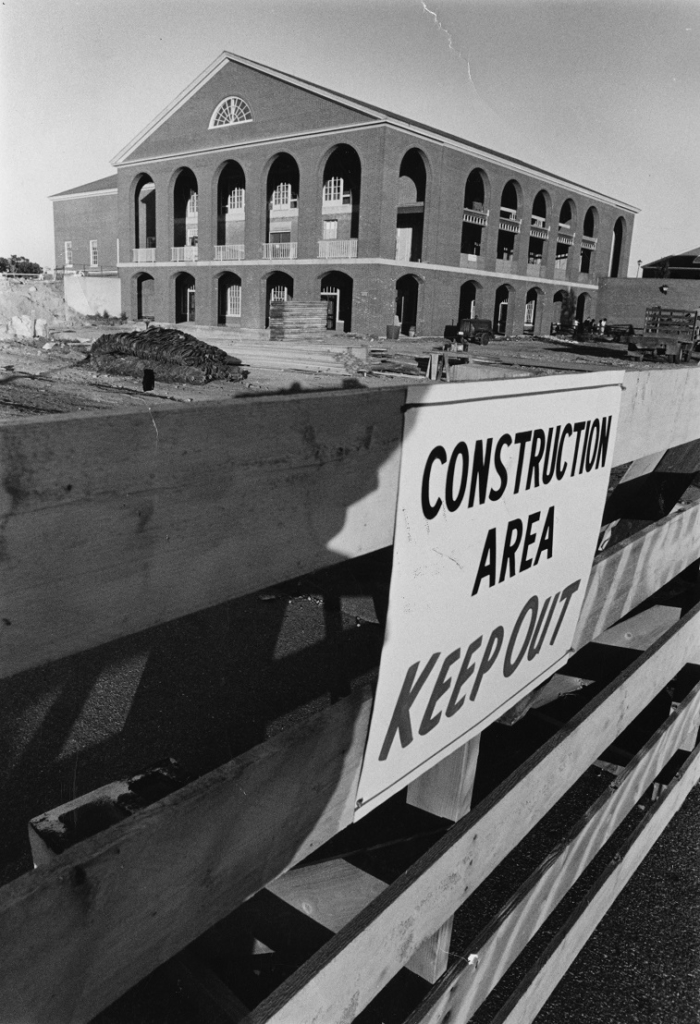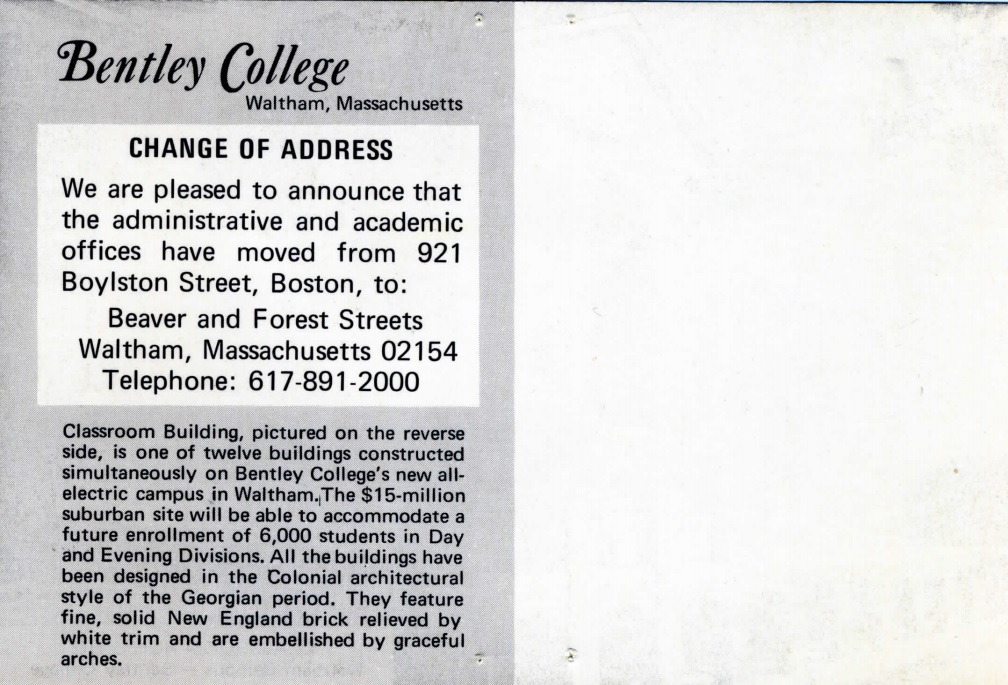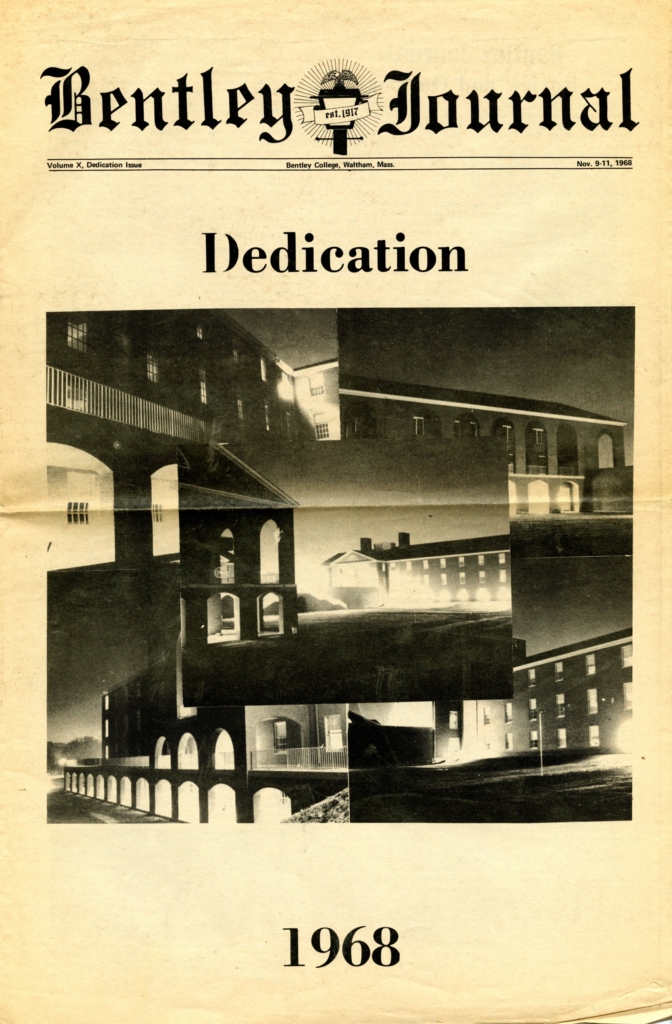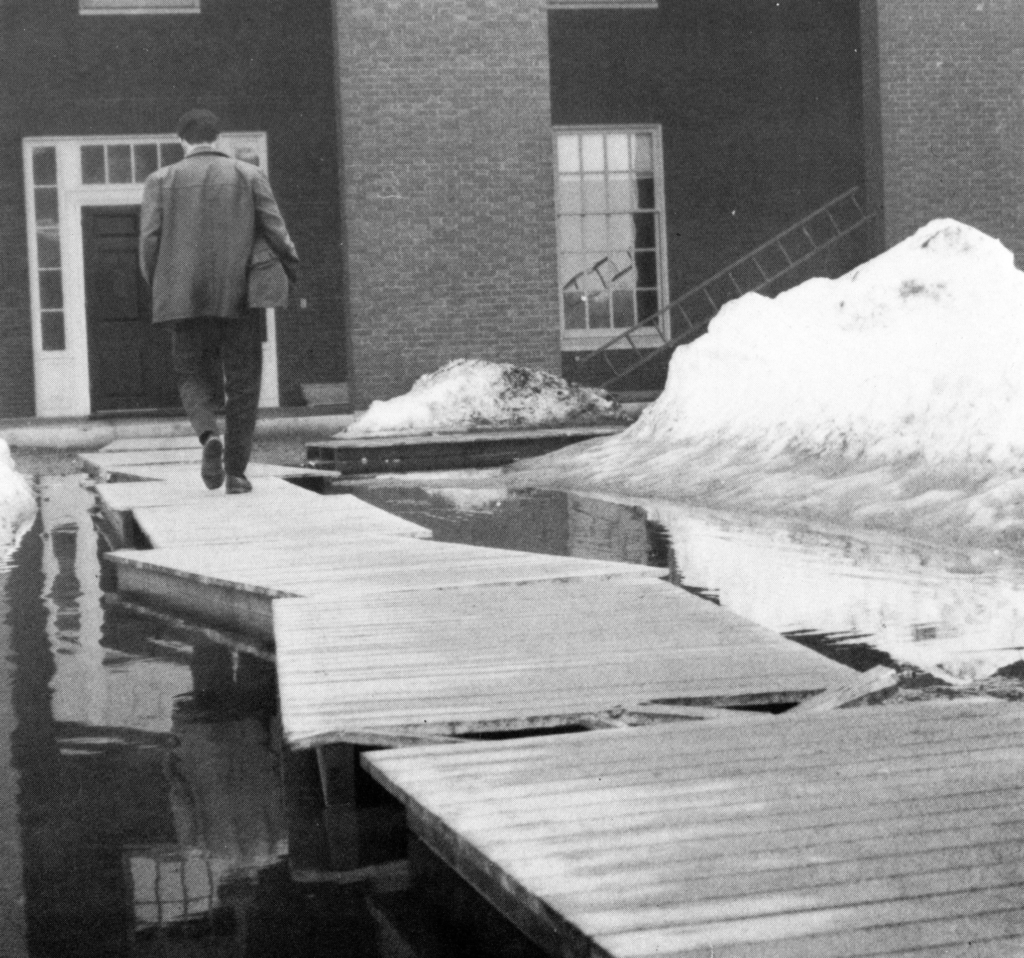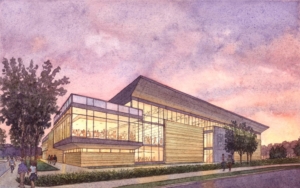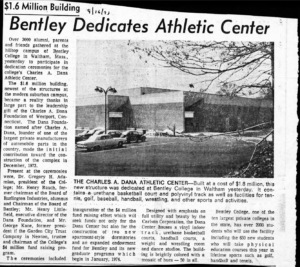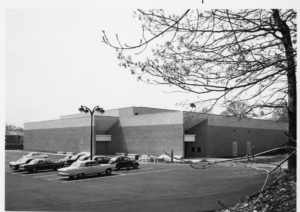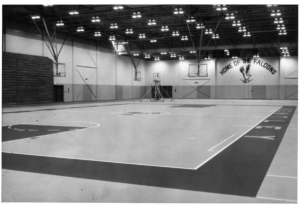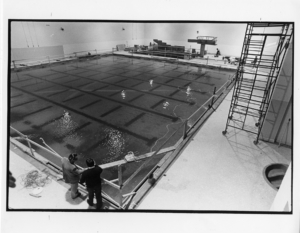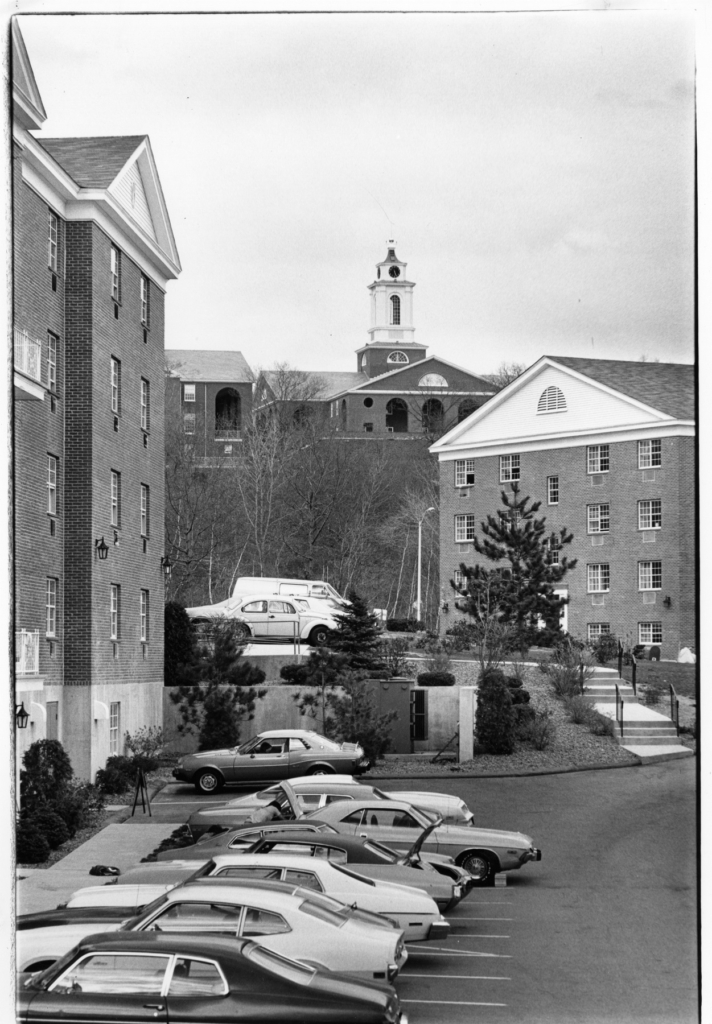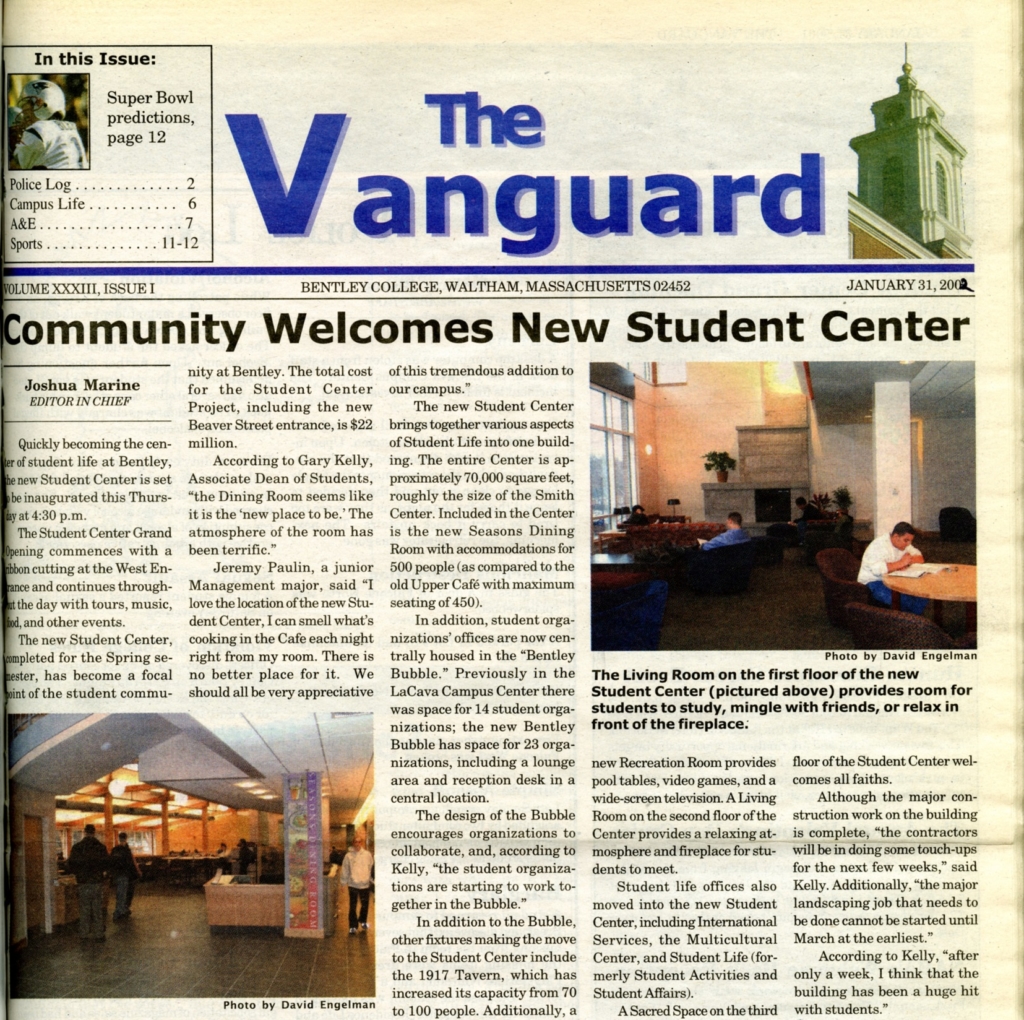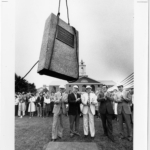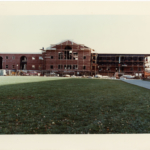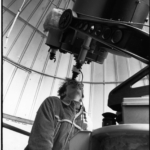Welcome to The Bentley Campus: From Boston to Waltham, the second Centennial year exhibit detailing the history of Bentley University. There are many benchmarks to measure Bentley’s growth over 100 years: the number of degree programs, enrollments, alumni, faculty, student life offerings, and athletic teams. One of the most impressive benchmarks is the development of Bentley’s campus. The Bentley Campus exhibit focuses on the important points in this development, from the original classroom on Huntington Avenue, to Boylston Street and locations across the Back Bay, to Cedar Hill in Waltham.
The evolution of Bentley’s campus and facilities reflects the ways in which it responded to the changing needs and interests of its students, faculty and the business community it served. It also reflects the determination of its leadership to assure the school’s excellence and competitiveness. For the first several decades of its existence, Bentley was an urban “streetcar school” that offered a basic education in no-frills facilities. Many of its students studied part-time and at night, and were not interested in – and usually could not afford – many of the services and amenities that are so important to higher education today.
Beginning after WWII, the constraints of Bentley’s urban locale began to show. More students wanted a full and rich residential experience. Bentley’s leaders soon concluded that having the kinds of facilities necessary for the school to meet student needs and to continue to offer an excellent education would mean relocating and building an entirely new campus – one of the boldest moves in the history of American higher education.
Today, Bentley boasts a beautiful, well-maintained and technologically advanced campus. Improvements continue even now, with the recently concluded refurbishment and modernization of Jennison Hall and, on the Lower Campus, construction of what is sure to be a new landmark facility, the multi-purpose arena. Please enjoy this look at one of the most powerful and vivid strands in the narrative of Bentley’s rise to international prominence.
The original site of the Bentley School was Room 410 in Huntington Chambers at 30 Huntington Avenue, Boston. Harry Bentley, an expert on accounting, lectured in the room for the first time on February 26, 1917. The space belonged to the Howell Women’s Whist Club, but as they did not use it all the time for their card games, they willingly subleased the room to Bentley. This allowed Mr. Bentley to teach there three evenings a week, plus Saturday mornings, until he moved his school to 125 Tremont Street in July of that same year.
For nearly 50 years, 921 Boylston Street, Boston, was the nerve center of the Bentley School. Constructed in 1910 to showcase Dodge cars in the Back Bay, the six-story building was in bad shape when Harry Bentley first leased a portion of it in 1920. He fixed up the place, however, and bought the entire building when his accounting school became a non-profit institution in 1948. Five years later, President Maurice Lindsay acquired the adjacent 925 Boylston Street, which had been a former coffin warehouse. He also renovated 921 Boylston Street, giving it a modern facade in 1961. Today the building is numbered 915 and belongs to the Berklee College of Music.
921 Boylston Street contained large, non-air-conditioned classrooms, and each classroom was attached to a smoking room, because nearly everyone at Bentley smoked during the school’s first half-century. People also filled 921 Boylston Street for day and evening classes, and they attended three-hour-long CPA exam courses in the building’s largest classroom, Room 100 in the basement. Infamous for its terrible acoustics, Room 100 could seat 150 people, not all of whom were necessarily students. Indeed a few of the people who entered the classrooms in 921 Boylston Street were homeless men from a nearby railroad yard. The homeless men usually dozed off in back seats, but occasionally a homeless man would drunkenly burst into song. Whenever that happened, Bentley students would have to remove him, because the school lacked security officers while it was in Boston!
Campus amenities for students were relatively spartan in Bentley’s Boston days. Housing accommodations were scattered throughout the city, and the school buildings had precious little space to dedicate to activities. Students could pass time between classes in on-site lounging and smoking rooms, but generally needed to seek out other spaces in Boston to live, work, and socialize. Nearby cafes became meeting places for communal dining and study, and the Boston YMCA and public parks became sites for formal and informal athletic clubs.
Prior to 1959, when the school began to rent or purchase its own dormitory buildings, students were housed in various accommodations throughout the Back Bay and Brookline. Many of these were rooming houses run by local women, who would also provide meals and laundry services to the students. Mr. Bentley frequently sent pamphlets to students reminding them to behave appropriately in their rooms – “boisterousness” and “wise-cracking” were specifically discouraged!
373 Commonwealth Avenue, Boston, became Bentley’s Residence for Men in 1960. Bentley had occasionally rented dormitories for its male students, but 373 Commonwealth Avenue was the first dormitory that the school actually owned. A six-story building that had once been a high-end bordello, 373 Commonwealth Avenue had space for 136 residents, all of whom were required to wear jackets and ties for dinner in the dormitory. The residents could entertain lady friends, but only on a limited basis. “No women,” recalled one resident, “not even mothers, were allowed above the first floor.”
As part of its successful effort to obtain collegiate status from Massachusetts, Bentley bought three buildings between 1953 and 1960, and the largest of these buildings was 867 Boylston Street, a six-story lodging house. Purchased in 1957 for $175,000, 867 Boylston Street was subsequently remodeled and opened its doors to Bentley students in 1959. 867 Boylston Street (the first Lindsay Hall) greatly excited people in 1959, because it contained Bentley’s first cafeteria, its first infirmary, and its first real library.
From 1957 to 1965, the construction of the Prudential Center bombarded Bentley with noise and dust, playing a big role in the school’s decision to leave Boston. A massive commercial complex with a 52-story tower, the Prudential Center was built on the site of the old Boston and Albany Railroad Yard, which was right across the street from Bentley. The railroad yard had been noisy enough, but James Bulman ‘58 says that it was downright quiet in comparison to construction on the Pru. “You could hear the constant pounding of the pile drivers,” he recalls, and he describes the sound as a central part of his experience at Bentley.
In the early 1960s, Bentley grew too big for its tiny campus in Boston’s Back Bay. The institution dramatically raised its enrollment in 1961 (when it switched from being a two-year accounting school to a four-year accounting/business college with liberal arts classes), but it could not easily expand physically in its current location because it was hemmed in by massive new developments such as the Prudential Center, the Hynes Convention Center, and the Massachusetts Turnpike Extension. These developments made parking nearly impossible around Bentley, and they prompted President Thomas Morison and Dean Rae Anderson to make the decision to relocate the institution.
From 1961-1962, the school conducted a number of surveys asking Bentley community members for their thoughts on relocation. “By way of background information,” one survey said, “it is conceivable that the College may be required to double its facilities within the next decade.” While some suggested a new campus within Boston city limits, around 70% of respondents preferred the idea of a suburban campus. President Morison summarized these findings, saying that there was “widespread revulsion” against city traffic and parking concerns, and an “over-riding [sic] interest in campus atmosphere conducive to better academic and social life.”
Wealthy Boston families used to own grand summer retreats in Waltham, and the grandest of those retreats was the Vale, much of which is now the Bentley campus. Established in 1793 by Theodore Lyman, a Boston shipping magnate, the Vale belonged to five generations of the Lyman family, and it featured a still existent Federalist mansion. It also housed America’s oldest greenhouse, and it grew to include 400 acres. Over time, however, that acreage was split into pieces, some of which went to Ronald T. Lyman, whose heirs sold them to Bentley in 1962. Ronald T. Lyman acquired the Vale’s cow pasture (Bentley’s upper campus) and the Vale’s deer park (part of Bentley’s lower campus), but he had to sell off 39 of his acres to the DeVincents (a farming family) in 1943, because the New England textile industry, his primary source of income, was in decline.
The oldest structures on the Bentley campus are Lewis Hall, which was built in 1905, and the nearby Dovecote, which housed racing pigeons. Both of these buildings were erected by Ronald T. Lyman, who summered in the red brick hall with his family. Lyman was a businessman, but his true love was pigeon-racing (a popular sport among the old-time gentry in Waltham), and he raced pigeons until sometime before his death in 1962. After his death, Bentley purchased his summer home and dovecote and spent $55,000 to renovate the home. The money came from the children of Harold Mayo Lewis, a friend of President Morison, and because of their generosity the renovated home was officially named after Mr. Lewis in 1964.
Securing the financial resources to construct the new campus was a daunting part of the challenge of relocating an entire college. The cost of the acquisition of the Waltham site was $365,000 in 1962, but additional funds were needed for site preparation, design, moving and, of course, construction, totalling approximately $15 million. To help meet these expenses, a capital campaign was launched in 1967 called the Golden Anniversary Fund. With a goal of $3.5 million, it also coincided with the 50th anniversary of Bentley’s founding. The effort was chaired by Trustee Henry Rauch ’24, a future chairman of the Board for whom the Rauch Administration Center is named. President Thomas Morison traveled the country meeting with alumni in support of the fund drive, and one of the largest supporters was Solomon Baker ’24; today’s library collection honors his support.
Early plans for the Waltham campus varied greatly in layout. While one early drawing (below, left) shows a proposed central residence core, academic and administrative buildings would have been scattered. Soon after this proposal, a plan developed for 12 buildings in the configuration that we recognize today. In later photos though (below, center and right), you can notice one unique difference. The Tree Dorms were originally supposed to expand, forming a ring around the campus’ natural pond. However, Waltham residents did not want to lose their view of and access to the pond, so the plan was amended to leave it undisturbed.
The Waltham campus was carefully designed to be functional, attractive and to make a statement about the institution. The style chosen for the original twelve buildings was Georgian Colonial. As Dean Rae Anderson, who played a pivotal role in the design and construction, observed at the time: “The buildings, featuring fine, solid New England brick relieved by white trim and embellished by graceful arches, stand in full harmony with the regional heritage of the college.” This traditional design, with some minor variations, has remained the basic look of the campus ever since.
Bentley leaders wanted to share their excitement about the new Waltham campus, so in the summer of 1966 they held the “Projection Twelve Conference” at neighboring Brandeis University. Five hundred attendees listened to updates on the architectural model of the campus, as well as the fund-raising efforts of the Golden Anniversary Campaign. The full-day conference also included an afternoon bus tour of the 100-acre Bentley campus. During the evening portion of the program, President Morison proudly announced that gifts and grants for the campus construction had recently surpassed $2 million.
Groundbreaking for the Waltham campus took place on April 24th, 1965. Presidents Morison and Lindsay were joined by members of the Board of Trustees, the Bentley faculty, and Waltham Mayor Austin Rhodes. Over 1,000 others attended to hear ceremonial remarks and learn about the new campus. In his speech, Dean Rae Anderson said that the new campus should “serve as a stimulus to our students to greater intellectual effort; to our faculty, as a challenge to more effective teaching and greater concern for the student… to the alumni, as evidence that their alma mater is not content to rest on past laurels; to our sister institutions, that Bentley is rising to the challenges of the day.”
The creation of Bentley’s Waltham campus lasted from 1963 to 1968, and it occurred in two phases (1963-1965; 1965-1968). The first phase (spiffing up the lower campus) was easy and inexpensive, but the second phase (creating the upper campus) was difficult and costly, because it involved blasting away much of Cedar Hill, putting in roads and utilities, and constructing twelve Georgian-style buildings. To pay for all of this, Bentley worked closely with Massachusetts Senator Ted Kennedy to obtain grants and loans from the federal government, which provided roughly three-fifths ($8,897,000) of the $14,679,000 that it took to create the upper campus. President Thomas Morison, who headed up fundraising, and Dean Rae Anderson, who oversaw construction, had conservative architectural tastes, and they chose to fill the campus with traditional red brick buildings rather than with sixties-style concrete monoliths. They also made the library the focal point of the campus, because they wanted to show that Bentley had evolved from a barebones accounting school into a multi-disciplinary college.
On November 11, 1968, Bentley held a televised dedication ceremony for its newly constructed Waltham campus. College employees had scrambled to make the campus ready to open in the fall of 1968, and for a while it looked as though they might not succeed. Throughout the summer of 1968, Bentley’s faculty, staff, and work-study students made runs in their cars from Boston to Waltham, transporting property from the school’s old campus to its new one. They completed their runs before opening day, but shortly thereafter the coldest, rainiest academic year on record set in, transforming the as-yet-to-be landscaped Waltham campus into a sea of mud and ice. Because of this, people had difficulty getting around and often slipped and fell. They took this hardship in stride, however, and were proud of their new campus, because they knew that its creation had been a spectacular feat.
Almost from the time Bentley moved to Waltham, its leaders hoped to acquire more land for campus growth. Several parcels in the area seemed promising and two that had long been considered prime expansion sites became available, soon increasing the size of the campus from 103 acres to nearly 160.
The DeVincent land, contiguous to the Lower Campus, was the site of a farm stand operated by the DeVincent family for decades. The family decided to sell in 1999, and after a brief negotiation, Bentley acquired the 33 acre site for $17 million — a sharp contrast with the $365,000 price for the original 103 acres in 1962. The farm site was developed with athletic facilities, parking and housing, and a large part remains for future growth.
In 2000, the Army Corps Land, on Forest Street, became available. This land had been used by the federal government for a variety of purposes since WWII. Under a special program, the government made it available to Bentley, the City of Waltham, and the Gann Academy, a private high school. Bentley received 20 acres, with the only cost being clearance of the existing buildings and a small contribution to the city’s development costs. Graduate housing was soon built there, with space available for future development.
The move to Waltham enabled Bentley to advance from rudimentary recreational offerings like a bowling club to establishing a nationally competitive intercollegiate athletic program, as well as comprehensive intramural and health and wellness programs. The first step in this evolution was the construction of the Dana Athletic Center, which opened in 1973. Its original 43,000 square feet of space has been expanded several times, including the addition of a pool in 1984, three other significant expansions in the 1990s, and the most recent renovation in 2006.
The acquisition of the DeVincent land had a huge impact on athletics, as it allowed space for the construction of a new baseball diamond, a soccer field with track, a field hockey/lacrosse field, and expansion and improvements to the football field. Ground was recently broken for a multi-purpose arena opening in 2018. This much needed facility will provide space for large events like convocation, concerts, and lectures and will be the home rink for Bentley’s Division I hockey team and is sure to become a landmark of the Bentley Campus and the City of Waltham.
One of the most important dynamics that followed the move to Waltham was the increasing sophistication of student life. Being able to offer a richer student life experience had been one of the prime reasons for the relocation, and college leaders moved quickly to realize this goal. In the first years in Waltham, Bentley remained essentially a commuter school, but this changed with a residence hall building boom that began in 1972 with the construction of Boylston Hall. Over the next 16 years, almost 500,000 square feet of residential space was constructed. By 1988, when the Orchard Apartments were completed, Bentley had evolved from a weekend commuter college to a fully residential community — changing the culture of the institution in step with this physical development.
The acquisition of the DeVincent and Army Corps parcels in the late 1990s made possible further enhancements to the campus. Parking was moved to the periphery, including the “farm lot” and two garages. This led to the creation of the “green space” in the center of the Upper Campus, which quickly became a popular gathering place at all hours. The LaCava Campus Center had been expanded several times to provide programs to support the students living on campus. But in 2002, it was replaced by a new Student Center located in the midst of the residential sector of campus, and an addition was completed in 2015. Today, Bentley is proud to have such modern and sophisticated student life facilities and programs.
The growth and expansion of academic and administrative facilities at Bentley reflect the evolving strategic needs of the institution. Beginning in the early 1980s, approximately 250,000 square feet of space for academic and administrative purposes was added to the campus. The Adamian Academic Center, constructed in 1983, was originally called the Graduate Center and was a response to the growth in the graduate school, which had been established less than a decade before. In 1986, the Rauch Administration Center was constructed to house the offices of the president, the vice presidents, admissions and other administrative units, and had the added benefit of opening space in Morison Hall for faculty offices. The President’s House, made possible by a gift from philanthropist Alex Manoogian in 1982, created space for entertaining alumni and friends of the college.
In the late 1990s, President Joseph Morone championed of the use of technology in education, which reflected its importance in business. Facilities constructed in these years included a constellation of high tech teaching and research facilities, the best-known of which is the Trading Room. The Smith Academic Technology Center was completed in 2000. As its name suggests, it was designed to offer a technologically advanced environment for teaching. A complete renovation of the library in 2006 supported technology and refreshed one of the campus’s original facilities.
As Bentley looks to a new century, the growth and improvement of its campus continues. Under President Larson’s leadership, Jennison Hall has been completely refurbished and expanded. Originally called the Classroom Building, Jennison Hall has always been an important part of the Upper Campus academic quadrangle and its renovation showcases Bentley’s desire to meet the rapidly evolving challenges of a 21st century business education.
To view a video playlist showing highlights of the Bentley campus development, please visit this link.

